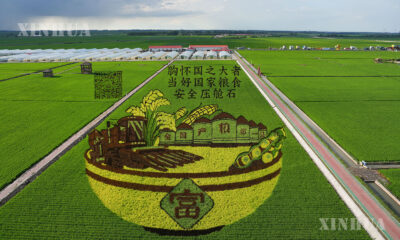Media
ရပ်ဝန်းနှင့်ပိုးလမ်းမ အဆိုပြုချက်က ဖွံ့ဖြိုးဆဲနိုင်ငံများအတွက် ဖွံ့ဖြိုးတိုးတက်မှုနှင့် ကွန်ရက်ချိတ်ဆက်မှုကို မြှင့်တင်ပေး
ချီကာဂို၊ ဇူလိုင် ၇ ရက် (ဆင်ဟွာ)
တရုတ်နိုင်ငံက အဆိုပြုတင်သွင်းသည့် ရပ်ဝန်းနှင့်ပိုးလမ်းမ အဆိုပြုချက်သည် အခြေခံအဆောက်အအုံများတည်ဆောက်ခြင်းအားဖြင့် ဖွံ့ဖြိုးဆဲနိုင်ငံများကို ဖွံ့ဖြိုးတိုးတက်မှုနှင့် ကွန်ရက်ချိတ်ဆက်မှု မြှင့်တင်ပေးရာတွင် အထောက်အကူဖြစ်စေကြောင်း အမေရိကန်နိုင်ငံ Illinois Institute of Technology in Chicago မှ တက္ကသိုလ် ပါမောက္ခတစ်ဦးဖြစ်သူ Khairy Tourk က ဆိုသည်။
အမေရိကန်နိုင်ငံ Illinois Institute of Technology in Chicago မှ တက္ကသိုလ် ပါမောက္ခ Khairy Tourk က “ အဲဒါက တကယ်ကို မရှိမဖြစ် ကွန်ရက်ချိတ်ဆက်မှုစီမံကိန်းတစ်ခုပါ၊ ကျွန်တော်တို့ဟာ တရုတ်နိုင်ငံနဲ့ အာရှတိုက်၊ ဥရောပတိုက်နဲ့ အာဖရိကတိုက်နဲ့ အခြားနိုင်ငံတွေကို ရုပ်ပိုင်းဆိုင်ရာ ချိတ်ဆက်မှုအဖြစ် ရှုမြင်နေကြပါပြီ၊ အဲဒီလိုချိတ်ဆက်မှုဟာ လမ်းတွေ၊ ရထားလမ်းတွေ၊ သင်္ဘောဆိပ်ကမ်းတွေနဲ့ တံတားကြီးတွေကိုတည်ဆောက်ရာကနေ လုပ်ဆောင်နိုင်ခဲ့တာပါ”
ဖွံ့ဖြိုးတိုးတက်မှုကိုနှောင့်နှေးစေတဲ့အကြောင်းအရင်းတစ်ရပ်ကတော့ အခြေခံအဆောက်အအုံဖြစ်ပါတယ်။ သူတို့ဆီမှာ လမ်းတွေ၊တံတားတွေ ဆိပ်ကမ်းတွေဆောက်ဖို့ငွေလုံးငွေရင်းမရှိကြပါဘူး၊ အခု တရုတ်နိုင်ငံရှိလာပါပြီ။ တရုတ်နိုင်ငံမှာ ငွေအရင်းအနှီးနဲ့အတူ စံချိန်တင်အချိန်ကာလအတွင်း အခြေခံအဆောက်အအုံတွေကို ဆောက်လုပ်နိုင်တဲ့အတွေ့အကြုံလည်းရှိပါတယ်
အဲဒါက ပြည်သူတွေအချင်းချင်းချိတ်ဆက်မှုလည်းဖြစ်ပါတယ်။ ကျွန်တော်တို့ ပြည်သူတွေအချင်းချင်းဖလှယ်နိုင်ခဲ့ကြတယ်၊ ဒါဟာလည်း ယဉ်ကျေးမှူတွေကြားဆွေးနွေးမှုတွေကတစ်ဆင့် ကွန်ရက်ချိတ်ဆက်မှုတွေဖြစ်လာတာပါပဲ” ဟုဆိုသည်။ (Xinhua)
…………………………
(English Version)
GLOBALink | BRI helps developing countries boost growth and connectivity: American expert
CHICAGO, July 5 (Xinhua) — American academic Khairy Tourk says that the China-proposed Belt and Road Initiative has helped developing countries boost growth and connectivity by building infrastructure.
American academic Khairy Tourk says that the China-proposed Belt and Road Initiative has helped developing countries boost growth and connectivity by building infrastructure.
SOUNDBITE (English): KHAIRY TOURK, Professor of economics at the Illinois Institute of Technology in Chicago
“It’s essentially a connectivity project. We see physical connectivity in the sense of connecting China with Asia, Europe and Africa, and other nations. And this is done through building roads, rails, ports, and bridges.
One barrier that hindered the development was that of infrastructure. They didn’t have the capital to build roads, bridges, ports, etc. Here comes China. It has both the funds and experience to build infrastructure in a record time.
It’s also connectivity between people. We have people-to-people exchanges. It was connectivity through dialogue of civilizations.”
Produced by Xinhua Global Service






